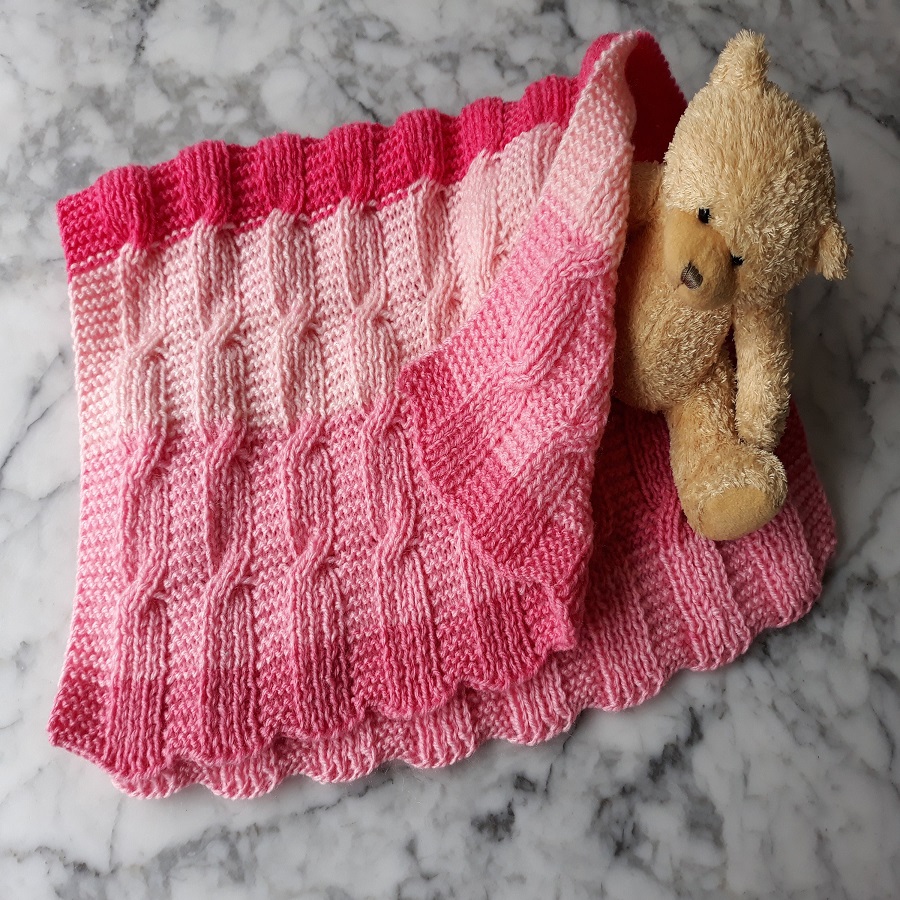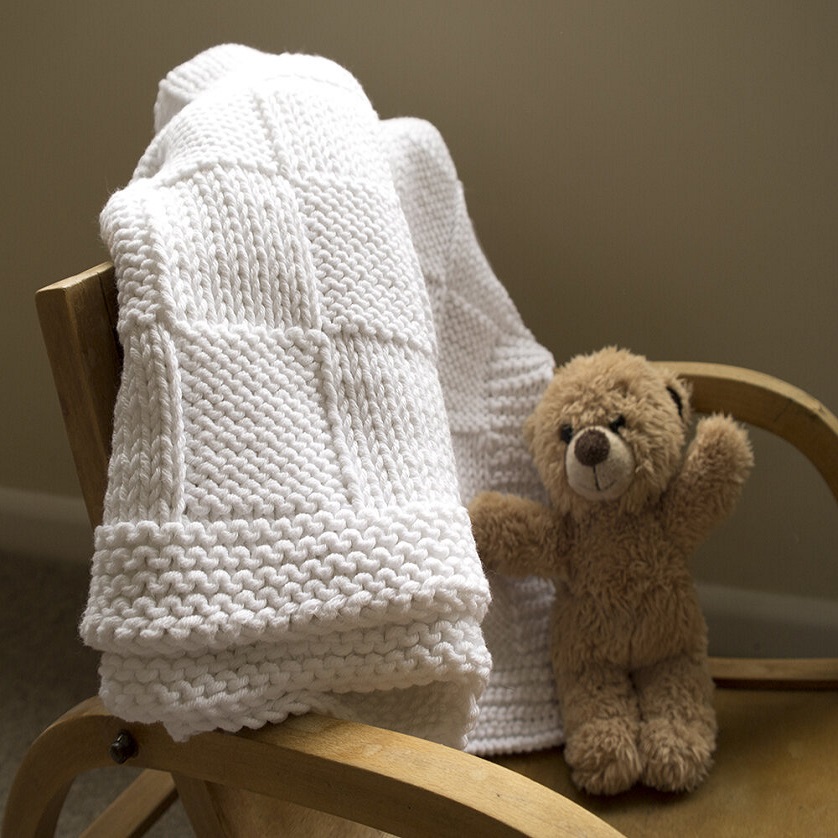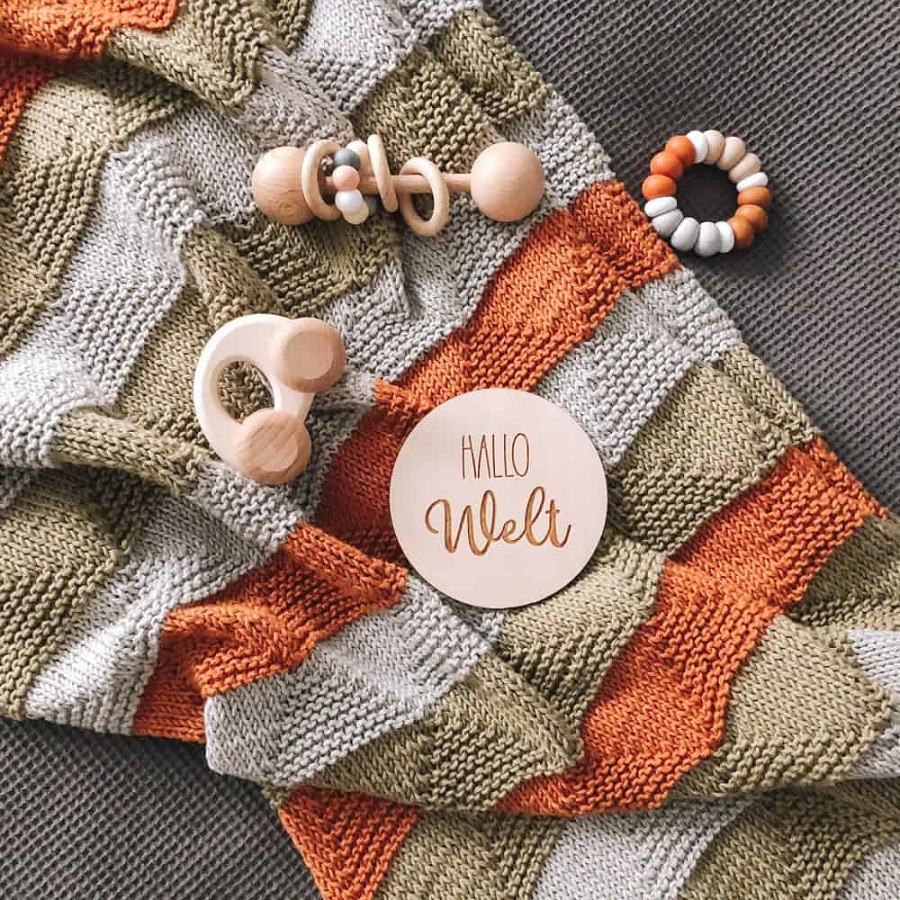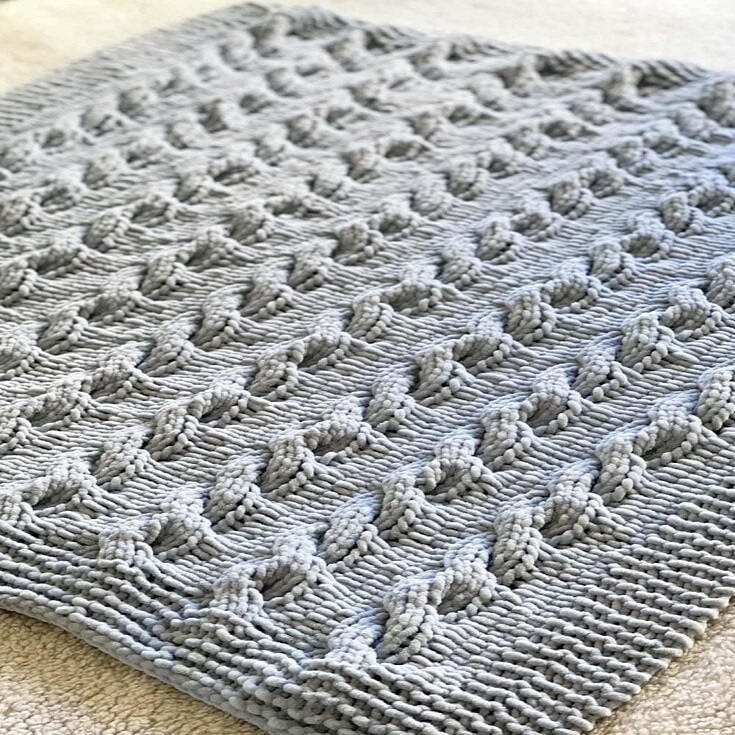Selecting the Perfect Yarn for a Baby Blanket
The yarn you choose for your baby blanket knitting pattern is crucial. It affects the blanket’s feel, warmth, and durability. Here’s how to pick the best yarn for your project:
- Fiber Content: Opt for yarns with natural fibers like cotton or bamboo for softness. Avoid wool for babies with sensitive skin.
- Weight: Choose a light to medium weight yarn. It should be thick enough for warmth, yet light enough not to be bulky.
- Texture: The yarn should be smooth and even. This makes for easier knitting and a more comfortable blanket.
- Washability: Babies can be messy. Ensure the yarn is machine washable for easy cleaning.
- Safety: Ensure the yarn is free from chemicals and safe for baby use. Look for hypoallergenic labels if necessary.
- Color: Soft, pastel colors are a classic choice. Yet, bold colors or patterns can make a fun, modern blanket.
Take your time to feel and compare yarns before deciding. Remember, the right yarn makes all the difference in your baby blanket knitting pattern success.
Understanding Basic Knitting Stitches and Techniques
Before you start knitting your baby blanket, it is important to understand some basic stitches and techniques. These form the foundation of any knitting project and will help you create a beautiful and even blanket. Here is a quick overview:
- The Knit Stitch: This is the most basic stitch in knitting. Mastering the knit stitch will allow you to perform the majority of baby blanket knitting patterns.
- The Purl Stitch: This stitch is often used in combination with the knit stitch. It creates a bump on the fabric, adding texture to your work.
- Casting On: This is the process of creating the initial stitches on your needle. It’s the first step in any knitting project, including your baby blanket.
- Binding Off: Also known as casting off, this technique secures the final stitches in your work and prevents unraveling.
- Increasing: Adding stitches to your knitting is known as increasing, which allows you to shape the blanket.
- Decreasing: The opposite of increasing, decreasing removes stitches and is also useful for shaping.
With these basic stitches and techniques under your belt, you will be well on your way to starting your baby blanket knitting pattern. Practices these skills to gain confidence and ensure the success of your project. Remember, patience and practice are key for beginners.
Step-by-Step Guide to Knitting a Simple Baby Blanket
Before we dive into the actual knitting, let’s ensure we have everything we need. Gather your selected yarn, knitting needles (size recommended on your yarn label), a pair of scissors, and a tapestry needle for weaving in ends later.
Step 1: Casting On
Begin by casting on the number of stitches needed for the baby blanket’s width. A good size for a baby blanket is about 30 inches wide, which may be around 90 to 150 stitches depending on your yarn and needle size.
Step 2: Knit the First Row
Once you have your stitches cast on, knit your first row. This row sets the foundation for your baby blanket knitting pattern.
Step 3: Continue Knitting
Continue to knit each row, keeping the edges neat. For beginners, sticking to the knit stitch in every row creates the garter stitch texture, which is stretchy and cozy.
Step 4: Check Your Work
As you’re knitting, measure your work occasionally. You’ll want your blanket to be square, so aim for the same length as the width you’ve chosen.
Step 5: Binding Off
When you’ve reached the desired size, it’s time to bind off the stitches. This prevents your work from unraveling.
Step 6: Weave in Ends
Use your tapestry needle to weave in any loose ends. This will give your blanket a finished look and ensure everything stays secure.
Step 7: Final Touches
Give your blanket a gentle wash according to the yarn’s instructions, and lay it flat to dry. This will help even out the stitches and soften the yarn.
Follow these steps, and you’ll have a beautiful, handmade baby blanket ready for snuggles and warmth. It’s a simple process that even novice knitters can proudly master. Remember, practice makes perfect, so keep knitting and enjoy the journey!
 Incorporating Simple Patterns and Textures
Incorporating Simple Patterns and Textures
While knitting a baby blanket, adding simple patterns and textures can elevate the end product. Patterns and textures offer visual and tactile stimulation for babies. They also add a personal touch to your handmade gift. For beginners, it’s best to start with uncomplicated designs. Here are some patterns and textures to consider:
- Garter Stitch: Just knit every row to create a squishy, stretchy fabric that is perfect for a beginner’s baby blanket knitting pattern.
- Stockinette Stitch: Alternate between knit rows and purl rows. This creates a smooth side and a textured side, giving the blanket two distinct looks.
- Seed Stitch: Alternate between knit and purl stitches within the same row. This pattern gives a bumpy texture that’s great for sensory touch.
- Ribbing: Combine knit and purl stitches to create ribs. This can be used for the blanket’s borders for a snug, stretchy edge.
- Stripes: Use different colors to create stripes without needing complicated techniques. Switch colors every few rows for a colorful, modern look.
Keep your patterns simple and avoid overcomplicating the design. This will help ensure that the blanket is not only beautiful but also practical and cozy for the baby. As you gain experience, you can experiment with more intricate patterns and textures. For now, focus on mastering the basics and creating a lovely, snuggly blanket that any baby would be fortunate to have.
Tips for Finishing and Edging Your Baby Blanket
Proper finishing and edging are essential for a professional-looking baby blanket. Here are some practical tips:
- Choose a Suitable Edge Stitch: A clean and functional edge stitch is vital. Consider ribbing, a picot edge, or a moss stitch for durability and style.
- Blocking: After binding off, block your blanket. Lay it flat and shape it evenly. This process reduces unevenness and curls in the edges.
- Neatening Seams: If your baby blanket is made from multiple pieces, ensure seams are neat. Use a mattress stitch for virtually invisible joins.
- Stable Border: A sturdy border can prevent stretching. Crochet a single or double crochet border around your blanket for stability and a neat finish.
- Securing Loose Ends: Securely weave in ends to prevent unraveling. A tapestry needle works well for this purpose.
- Final Inspection: Examine your blanket for any loose stitches or uneven areas. Make adjustments as needed for a perfect finish.
By following these tips, you will enhance the durability and appearance of your baby blanket. Precision in finishing touches reflects your craftsmanship and care in the baby blanket’s creation.
Washing and Caring for Hand-Knit Baby Blankets
Caring for hand-knit baby blankets correctly extends their life and maintains their beauty. Here are some essential care guidelines:
- Read the Yarn Label: Always check the washing instructions on your yarn label before proceeding. This ensures you are using the correct settings.
- Gentle Washing: To preserve the blanket’s fibers, wash it on a gentle cycle. Use a mild detergent that is soft on fabrics. Cold water is ideal to prevent shrinking and bleeding colors.
- Avoid Fabric Softeners: Skip any fabric softeners as they can break down the yarn fibers over time. Instead, opt for a gentle detergent.
- Drying: Air-drying your baby blanket is the best option. Lay it flat on a clean, dry towel. Avoid hanging, as this can distort the shape.
- Frequent Care: For blankets in regular use, frequent light washes are better than less frequent heavy washes. This helps maintain the quality and feel of the blanket.
- Spot Cleaning: For small stains, consider spot cleaning. Use a soft cloth dipped in a mild detergent solution to dab the stain gently.
- Storage: Store the blanket in a cool, dry place. Avoid plastic bags and instead opt for breathable cotton bags to prevent moisture buildup.
Following these care tips will ensure that your beautifully knitted baby blanket remains soft, colorful, and comfy for years to come.
Inspirational Ideas for Personalizing Baby Blankets
Creating a unique and personalized baby blanket knitting pattern can make your knitted gift truly special. Here are some inspiring ideas to add a personal touch:
- Monograms: Knit the baby’s initials into the blanket for a classic and timeless touch.
- Appliques: Sew on cute appliques like stars, moons, or animals. These add charm and character.
- Color Choices: Pick colors that match the nursery decor or the baby’s gender. Bright or contrasting colors can add visual interest.
- Embroidery: After knitting, embroider the baby’s name, birth date, or a sweet message.
- Texture Play: Mix different stitches to create various textures within the blanket.
- Bobbles and Tassels: Add playful bobbles or tassels to the corners of the blanket for a fun detail.
- Edges and Borders: Experiment with scalloped edges or lace borders for a decorative edge.
Remember to balance personal touches with practicality. The baby blanket should still be soft, safe, and comfortable for the baby. These personalizing tips will show the love and care you put into your baby blanket knitting pattern.
 Common Mistakes to Avoid for Beginner Knitters
Common Mistakes to Avoid for Beginner Knitters
As you embark on your journey to create a baby blanket knitting pattern, avoiding some common mistakes can help streamline the process. Here are essential tips to consider for beginner knitters:
- Too Tight Stitches: A common mistake is knitting the stitches too tightly. This makes it hard to insert the needle into stitches for the next row and can result in hand strain. Practice maintaining an even tension.
- Ignoring Gauge: The gauge is crucial for the final size and look of the blanket. Always knit a test swatch to check your gauge before starting the project to avoid a blanket that’s too small or too large.
- Forgetting to Count Stitches: Count your stitches regularly, especially when starting out. This helps to keep the correct stitch count and prevent an uneven blanket.
- Neglecting to Check Progress: Periodically check your work. Look for dropped stitches or mistakes early on so they can be fixed before they affect more of the blanket.
- Using the Wrong Needle Size: Needle size affects the feel and drape of the blanket. Make sure to use the size that matches the yarn weight and the recommended tension for your baby blanket knitting pattern.
- Not Weaving in Ends Properly: Loose ends can unravel and spoil your work. Weave them in carefully to secure the blanket’s stitches.
- Avoiding New Techniques: While it’s best to start simple, don’t shy away from learning new stitches and techniques as they’ll improve your skill set and the quality of your knits.
By paying attention to these common pitfalls, you will create a baby blanket that’s as error-free and beautiful as possible. Happy knitting!
